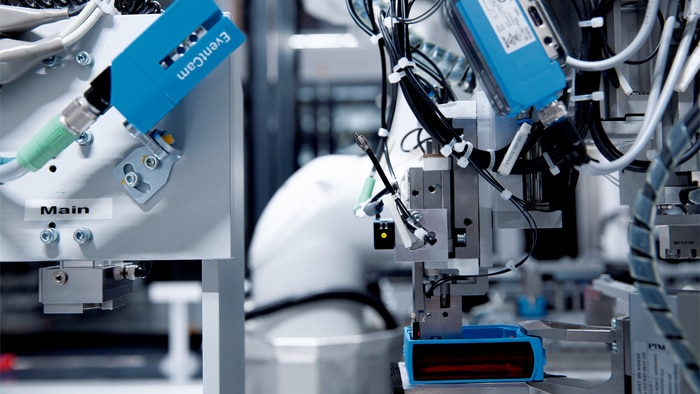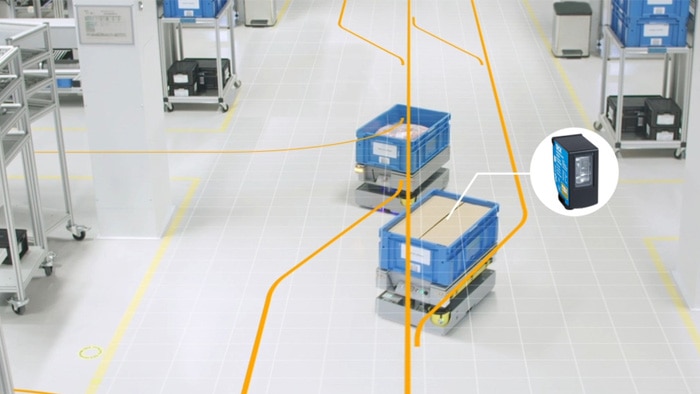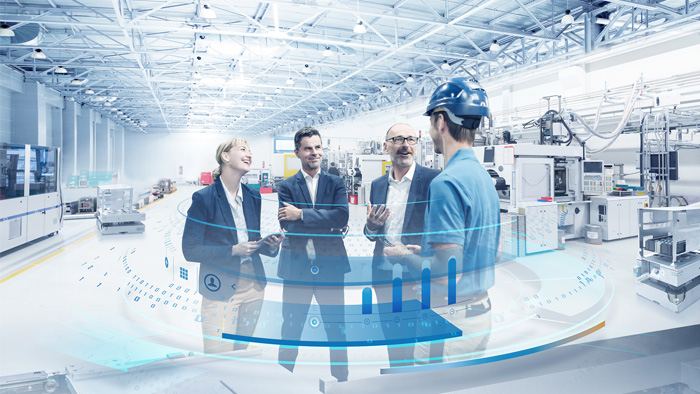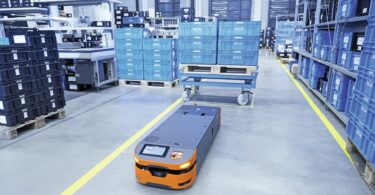New fields of application, new sensor solutions: SICK AG experts answer everything you need to know about concept sensors
The digital transformation of industry presents us with new challenges every day, fostering the need for new sensors and solutions. This, in turn, has created the notion of a concept sensor. In the development of concept sensors, customers and partners are involved right from the start to make the best possible use of competencies from all contributors. But what does that mean for the product development process? Get an inside look from SICK professionals in research & development, product management and sales.

From left to right: Sebastian Berblinger (Product Management), Tobias Guettler (Sales), Holger Lehmitz (Product Management), Maike Syassen (Product Management), Felix Lang (Research & Development)
How does SICK define “concept sensors” and where does this term come from?
Tobias Guettler, Sales: Typically, in development processes, product concepts are created on paper with detailed considerations from a wide variety of perspectives. We, however, value a “hands-on” product concept for our customers and involve them right from the start. This means that important key customers from the industry receive a product that they install and test in their systems, and they give us immediate feedback. The choice of the word “concept sensor” was a conscious decision as opposed to the term “prototype,” because with a concept, we develop a usable product which is quickly available for individual customers in the early development phases. Market and series maturity are secondary factors.
Felix Lang, R&D: We were also inspired by the automotive industry: At the leading trade fairs, the “concept cars” always cause a big stir. They feature the finest technology that cannot yet be mass-produced. The most important thing for car makers is customer feedback! On the one hand, R&D departments always want to push the technology, and what any developer wants most is to see the new technology in actual use. But we at SICK understand that the customer is not necessarily looking for a new product, but for a solution to a problem.
How do ideas for new concept sensors come about?
Maike Syassen, Product Management: When we talk about a technology push, there are always lots of ideas which we are not really comfortable with yet. We work together with the customers on applications that are not yet satisfactory or could be made better with a new approach. What’s needed here is always a good understanding of the application and the market.
Holger Lehmitz, Product Management: The task comes from the customer. Understanding the requirements in detail is very important here. A new approach can then be created from many years of experience from existing applications and new technological concepts.
Felix Lang, R&D: A very exciting aspect is the transfer of experience from the production areas at SICK, such as electronic card assembly or fully automatic production lines. We get a lot of inspiration from our own optimization of processes, and customers in turn are very happy with this.
When it comes to dynamic development processes, there is often talk of “accepted failure.” When and why do concept sensor processes fail, and how does dynamic development work differ here from the normal process of product development?
Holger Lehmitz, Product Management: Basically, the motto is: Identify errors as quickly as possible and fix them. Testing early on in the application is very important here. In addition, both SICK and the customer have to be precise, open, and honest with each other when describing the task to make sure we really list all the constraints. The main difference between dynamic and standard development is certainly the fact that the customer is involved in the process more intensively and at an earlier stage.
Sebastian Berblinger, Product Management: Sometimes we decide not to follow the chosen path to its end for various reasons; for example, because we learn things that make it not worth pursuing this path, or because the desired result can be achieved in a different way. But we always end up with something really new, and that’s the main difference from what we usually do.
Maike Syassen, Product Management: I would say there are usually three reasons to stop. First, the market is not as big as we first thought. Second, it is not possible to meet the application requirements well enough. Third, the technology is not yet ready.
Which methods do the concept sensor teams use for this development work and how are the teams structured?
Maike Syassen, Product Management: We use iterative processes. In the project plans, as in the conventional product development process, we also have milestones at which we decide whether to stop or keep going, but the loops, the iterations, are shorter. And we use dynamic working methods.
Sebastian Berblinger, Product Management: Ideally, dynamic work is a huge advantage because we proceed in stages and also get feedback from the market at different points during the process. This is better than completing a large-scale project in the traditional way, only to discover shortly before the end that the development needs to be changed. Dynamic work requires courage, because without courage, nothing new can be created.
Tobias Guettler, Sales: Studies show that the degree of innovation in companies also correlates with the willingness to take risks. Every single employee, whether from R&D, product management, sales or even management, must work together here.
Felix Lang, R&D: These are often people who have special skills, for instance, who anticipate developments and dare to implement something new. We have created our own production area at SICK called the “Speed Factory.” Production planners work to help us develop concept sensors with industrial reliability so that we can hand them over to customers without hesitation and obtain feedback from the market. In the Speed Factory, rapid prototyping processes are used in addition to mastered series processes.

What examples do we have of products that started out as concept sensors and are already successful on the market?
Maike Syassen, Product Management: The SICK EventCam provides images or videos that record a defined period of time immediately before and after asignal event has been triggered. The development process began with a product idea for a triggered event-based camera that can be used to identify failures in the production process. At Hannover Messe, we targeted certain customers with whom we were able to develop the camera during operation. Using the feedback loops already mentioned, we were, for example, able to optimize the software and the user interface more and more until we reached satisfactory market maturity.
Felix Lang, R&D: With this development, we worked together with the Speed Factory on a so-called re-use. We looked all over the group to find as many fully developed parts and components as possible. For example, we used housings, printed circuit boards and software from different business units. We managed to get a very complex product in the works very quickly by recycling existing knowledge for our project. In retrospect, this confirmed that all areas at our company are really doing a very good job and that we can rely on and trust each other.
Sebastian Berblinger, Product Management: With the OLS and MLS guidance sensors, we also started out with an existing product that was perhaps even over-performing in terms of hardware for the application and adapted it to our task. Within a short time, we created the “proof of concept” and the customers tried it out and tested it. Our customers were very satisfied with this quick solution.
Tobias Guettler, Sales: We can really confirm this when it comes to sales. Especially in the fast-growing fields of intralogistics and robotics, the sales figures speak for themselves. We don’t want to simply chase after trends, for example with automatic transport systems and collaborative lightweight robots, but actively shape them with marketable new products. It is exactly in these dynamic application areas that we want to use concept sensors.
Are concept sensors now becoming the standard procedure in R&D?
Felix Lang, R&D: The product development process has been revised. In doing so, a separate process class was created for these type of concept products. This means that if we want to use iterative processes to develop a product with the customer, be it a sensor or a service, we use this approach. We have also incorporated a corresponding mindset with certain principles, such as “fail early, fail safe,” which encourages product teams to break new ground.
Maike Syassen, Product Management: The product development process for series products of course still exists and dynamic elements are also used here, as with concept sensors.
Tobias Guettler, Sales: We are not only active in markets that are highly complex or involve a high degree of uncertainty, but also in ones that we know very well. With our standard processes that have been proven over time, we have achieved a high level of professionalism, from the idea through to development, market launch and acceptance by the customer. That is our foundation, and it is extremely important. New approaches are merely a good addition here.

What is special about this new way of working?
Maike Syassen, Product Management: It’s just great to get immediate feedback on things the customer can get their hands on in a short period of time. And I’m really excited about our fast-learning curves.
Tobias Guettler, Sales: I like the challenge of managing the uncertainties and complexities of our work with courage and a willingness to take risks.
Holger Lehmitz, Product Management: But you could also say, on the other hand, that our approach is characterized by caution, because we don’t just invest and tie up too much time and money in long-term processes. It takes a wide range of different skills and attitudes, such as impatience and curiosity, to make dynamic work successful.
Felix Lang, R&D: Concept sensors create a secure framework for us developers to try out solutions quickly and unconventionally. Without this framework, no one would dare to develop concepts and products so quickly.
Sebastian Berblinger, Product Management: SICK wants to continue to grow and develop. We want to open new fields of business and move into new areas. Concept sensors are simply the perfect tool for this.
Get a closer look at SICK's EventCam here. And want to learn more about the EventCam or other products? Contact a SICK representative today!





